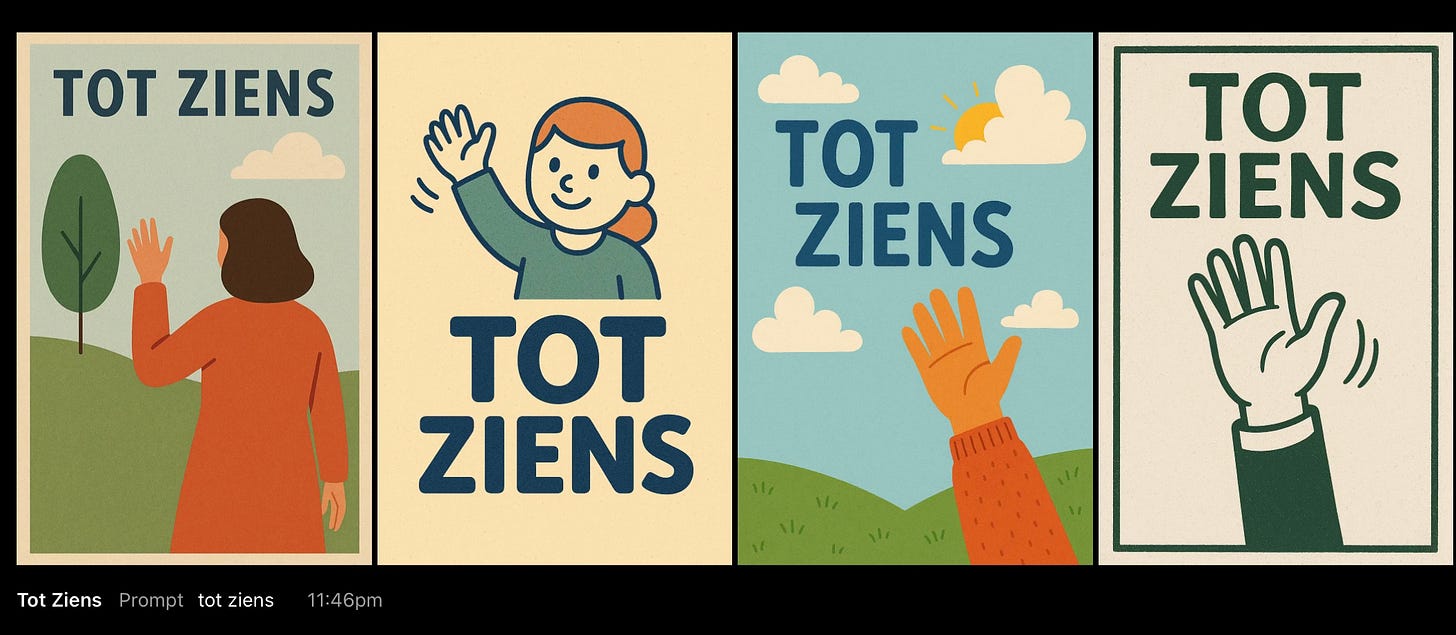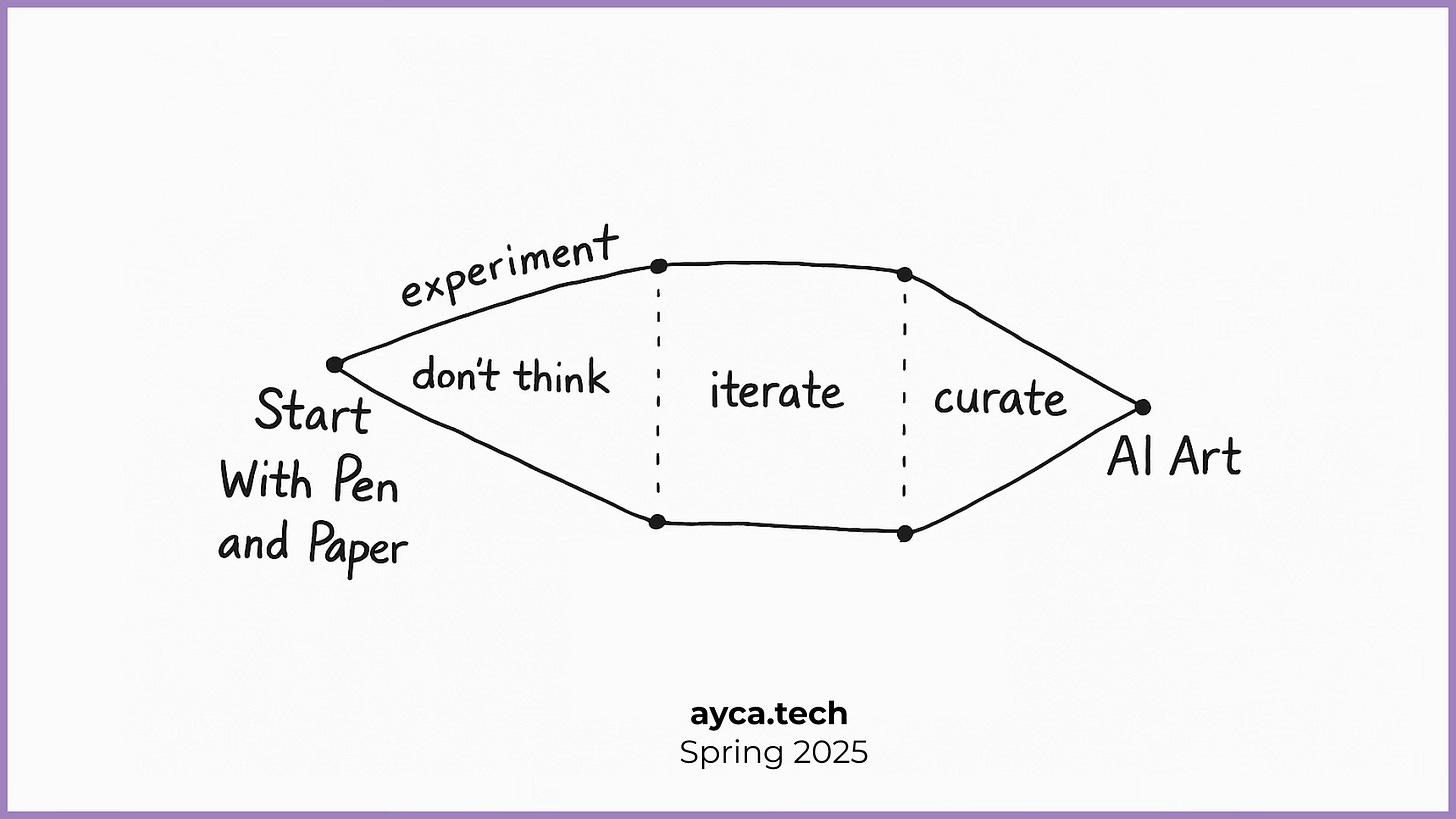Prompt Strategies for Creative Work
You’ve already played with AI tools: generated images, written stories and built your own prompts. This article is for people who are curious about the next layer of prompting with more structure.
In Spring 2025, people are generating images and exploring the joy of translating styles. (This brings up new debates which we’ll explore later.) For now, it’s genuinely inspiring to see so many people experimenting and sharing their process.
Generative AI tools today are fine-tuned and designed to help. Therefore, people often get great results on their first try. However, there’s a difference between a lucky first image and a conscious creation process. Like anything in life, you get better at it by doing it.
When I started generating images with AI in Spring 2022, I remember my heartbeat racing. My eyes teared up because I could see what I was thinking appear in front of me within minutes. Today I’m not writing this as someone who knows everything. I’m still learning, still refining. I’ve done enough experiments to help others prepare for the next phase.
This article is about moving past one-click generation. You might call it AI art or maybe not yet. What matters is how we show up to co-create.
Talking to Yourself in Front of a Magic Mirror
There’s a story about a temple with 10,000 mirrors. One day, a dog walks in barking aggressively, only to see 10,000 angry dogs barking back. Scared, he runs away. Later, a second dog enters, calm and playful. He’s met with 10,000 joyful dogs wagging their tails. The temple hadn’t changed. Only the dogs did.
Working with AI is similar, with a twist: this mirror doesn’t only reflect, it generates. It draws from a vast pool of patterns and information. Your tone, clarity and curiosity shape the outcome.
When you interact, you’re essentially activating keywords that prompt the AI to generate relevant (and sometimes unexpected outputs). While it can offer vast and diverse responses, it still relies on your critical eye and regular fact-checking.
AI doesn’t know your why. It responds to how you ask. That’s why prompts matter.
What Is a Prompt?
A prompt is a starting point: a phrase, sentence, or question that guides how the AI responds. It can include instructions, descriptions, examples or context. Think of it as the language you use to shape the collaboration.
Prompts come in different forms depending on the tool or creative goal and they all start with an intention. Below are five types of prompts, grouped by how they're used.
🪴 Seed Prompt
This prompt sets your intention, tone, and context. It's what you say at the beginning of a workflow to tell the AI what you're working on.
Use when: starting a new conversation or before giving an AI Workflow
Example: “I want to use an AI Workflow called Memory AI Art. I will first give content. Please read carefully and acknowledge. Once you understand, I will ask for your assistance in co-creating.”
🌅 Visual Prompt
This type focuses on the what detailed depictions of compositions, characters or scenes. It's especially useful for image generation or storytelling.
Use when: crafting a visual, scene, or story element
Example: “A quiet beach at night, soft moonlight, a woman walking…”
📋 Instructional Prompt
An instructional prompt tells the AI exactly what to do. You’re giving a task, command, or specific role.
Use when: you want the AI to teach, automate, or explain
Example: “Act like a visual artist. Explain this image’s composition.”
✏️ Refining Prompt
Once you have something, this prompt helps you polish or rephrase it. It’s part of the iteration process.
Use when: editing, simplifying, or improving something generated
Example: “Make this paragraph more concise and casual.”
🧠 Framework Prompt
You apply a mental model or metaphor to help the AI think more like you or more creatively. These prompts often guide strategy or reflection.
Use when: exploring speculative ideas or creating structured responses
Example: “Use a time travel metaphor to explore this policy idea.”
This Is the Rhythm I Follow
Every project begins away from the screen. I start with pen and pape because it gives me space to ask: What do I want to say, remember, or feel? Before I touch any AI tool, I try to understand the direction I’m heading. Writing or sketching gives me a place to return to later, when things start moving fast.
Then I experiment. This is the playful phase. I let go of expectations and allow the AI to surprise me. Sometimes it’s completely off. Sometimes it shows me something I hadn’t thought of. That’s part of the joy.
Once I see what’s possible, I begin refining. I adjust the prompt, shift the tone, tweak the framing slowly moving closer to what feels right. This is when emotion begins to take shape. The images or words start carrying something more than just data.
Eventually, I pause to curate. I move from generating to choosing. I look for what resonates and what holds emotional weight. Editing becomes a quiet, intuitive act of storytelling. It’s less about perfection and more about presence.
What I show in the end isn’t just a result. It’s a trace of the entire journey. Each image carries what I noticed, adjusted, and cared about.
That’s what makes AI art personal.
Frameworks, Workflows & Play
To go beyond one-click generation, it helps to adopt a mindset that combines structure and play. Poet and language artist Sasha Stiles describes working with AI as discovering a “third voice” a synthesis between human intuition and machine generation.
Co-creating with AI doesn’t always require hyper-clarity. Sometimes it means staying in the unknown a bit longer. Instead of aiming for the perfect result right away, start with a single prompt. See what comes back. Reflect. Then revise.
One way to create meaningful work is to start with what you want to see. Not what will impress. Not what might go viral. What makes you genuinely curious? That way, you’re not waiting for external validation, you’re following a thread that already belongs to you.
Flow states those moments where focus and creativity align often emerge when you work this way. To support flow, break your prompting into small, specific tasks with fast feedback. For example, ask the AI to generate the mood for a scene, not the whole story. Then keep building.
Homo Ludens by Johan Huizinga writes about play is a core element of culture. When we treat creative exploration as play, we reclaim our right to invent.
Be Aware of Decision Fatigue
Endless options, subtle revisions and micro-decisions can wear you down. That’s why taking breaks is part of the process, not a pause from it. Step away. Come back with fresh eyes. Trust your instincts. Notice what’s working and what isn’t.
In Creativity: A Short and Cheerful Guide, John Cleese reminds us that creativity isn’t a talent, it’s a way of operating. He explains how our best ideas often emerge not through pressure, but through play, patience, and taking time off-task. When we’re relaxed, our unconscious mind gets a chance to contribute. That’s when the unexpected shows up.
If your prompting practice starts to feel mechanical, soften it. Let go a little. Create the conditions for ideas to surface.
Conscious Co-Creation
When you collaborate with AI, you’re not just generating content. You’re offering your thoughts, your structure, your way of thinking. You’re training AI to co-create with you.
The solitary nature of these interactions can make it easy to forget how visible our inputs really are. So be cautious. Don’t share personal information that you wouldn’t tell a stranger. As we continue to learn how AI systems are trained on user data, protecting your privacy remains essential.
This is powerful and it carries responsibility. AI has been interacting with millions of people. Some are kind. Some are not. Be aware of what you share. Be mindful of your mental patterns. The threshold of AI being "neutral or smart" is behind us.
The mirror reflects what we bring to it.
Let’s bring something worth remembering :)
Ayça Turan
ayca.tech
April 2025, Netherlands








